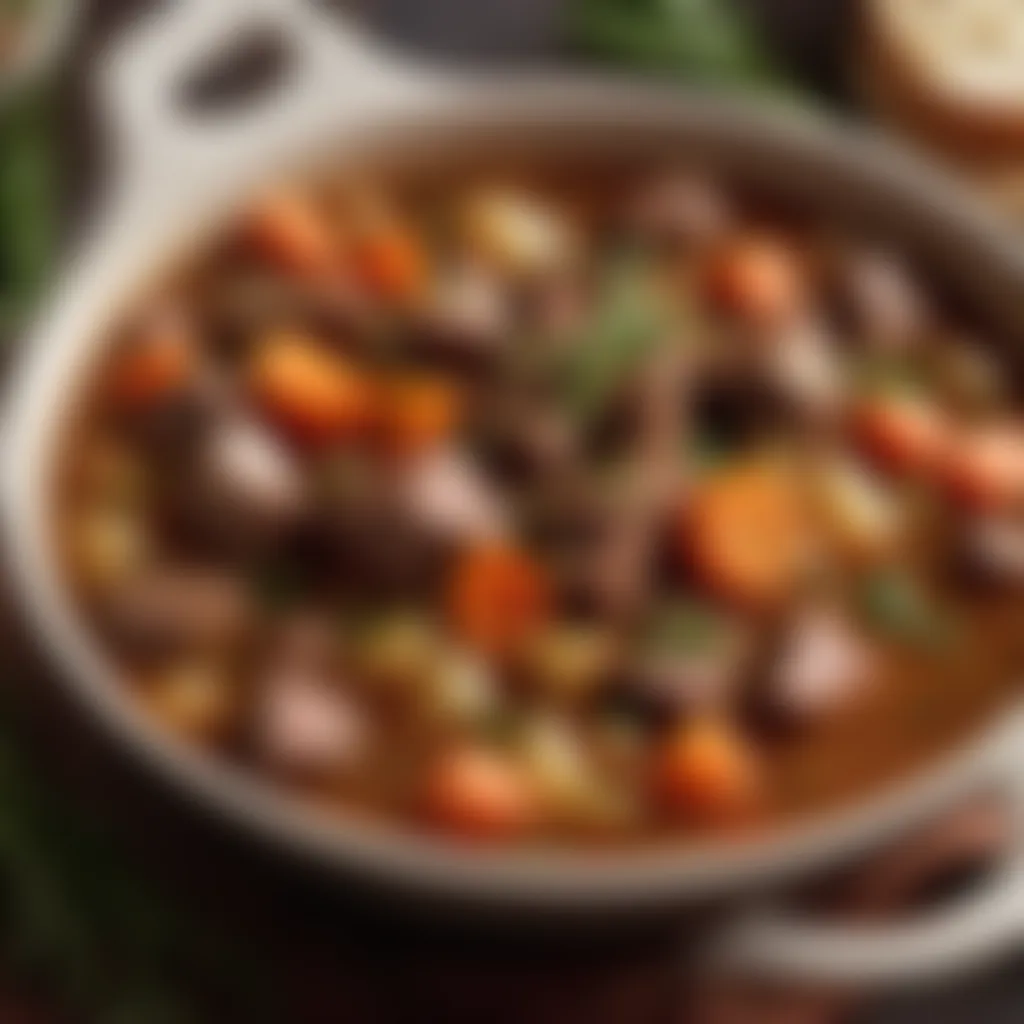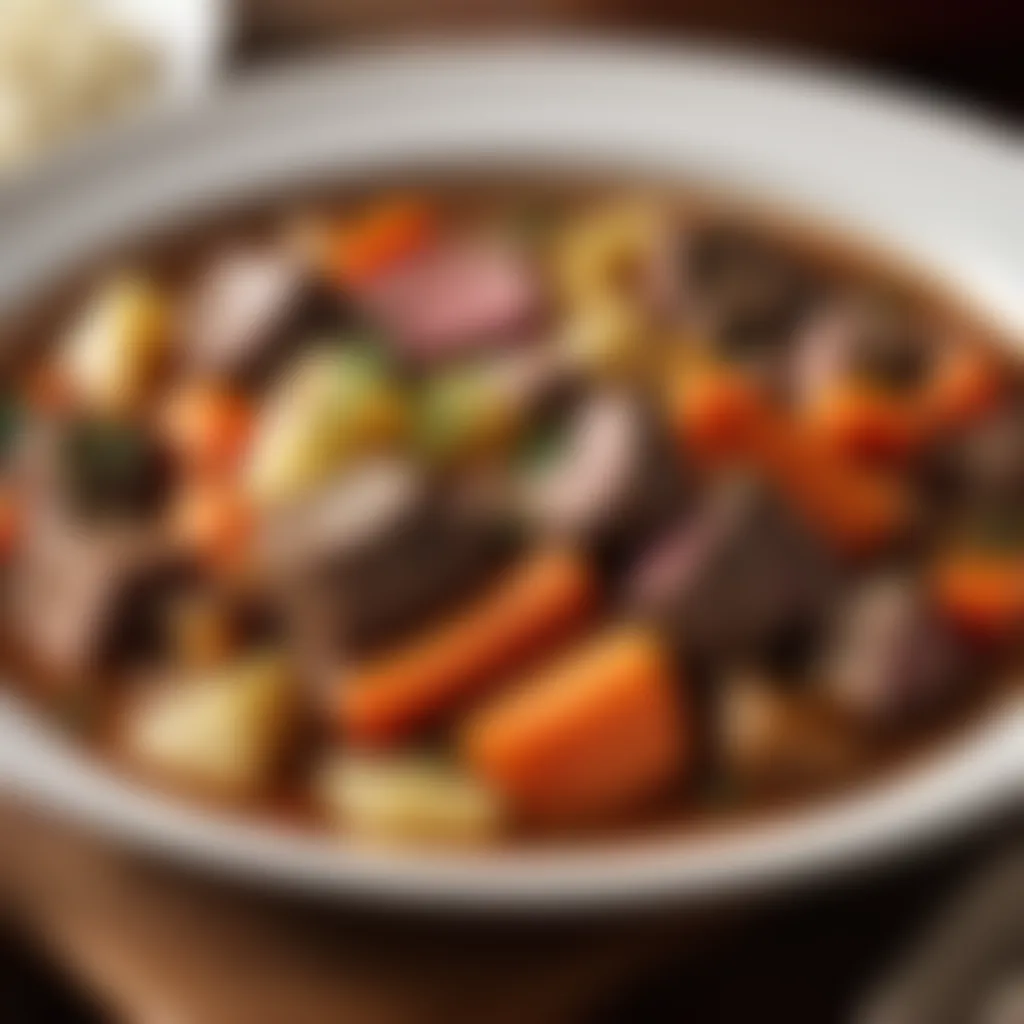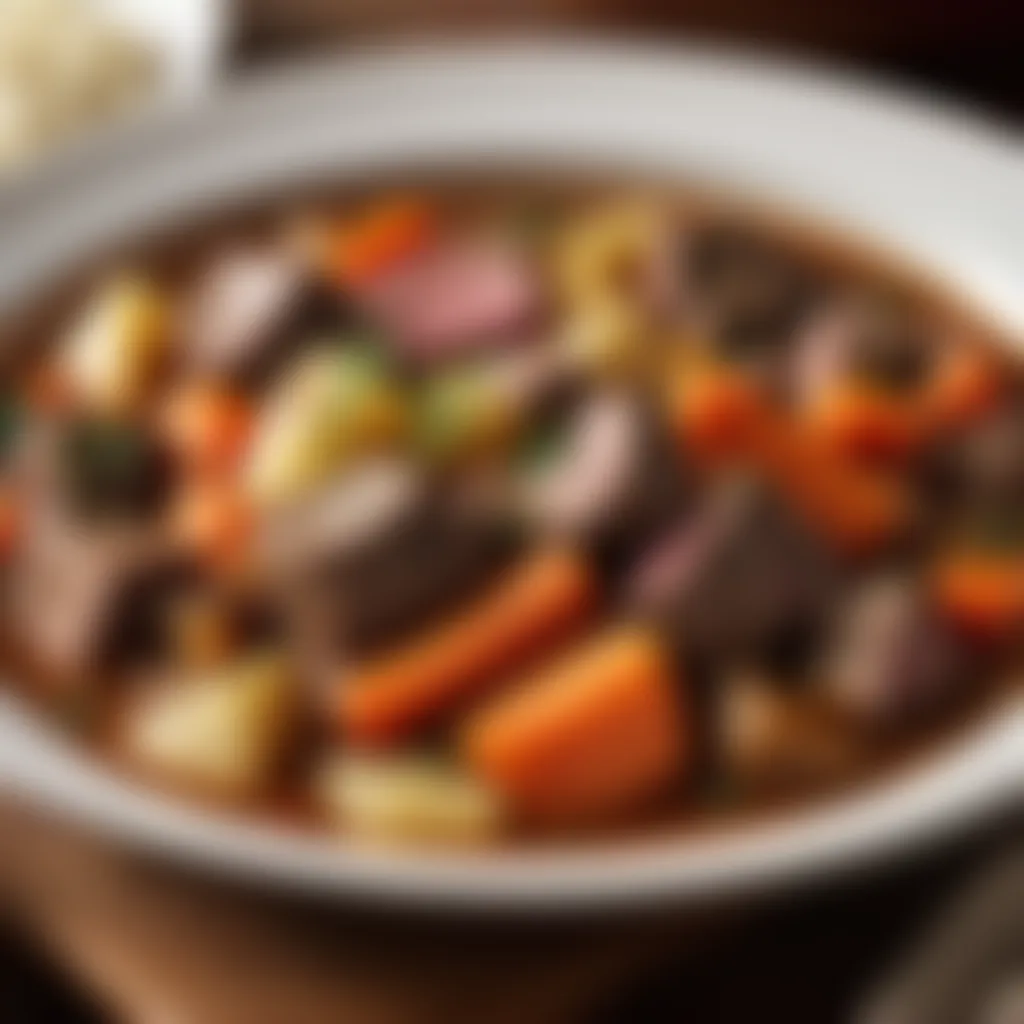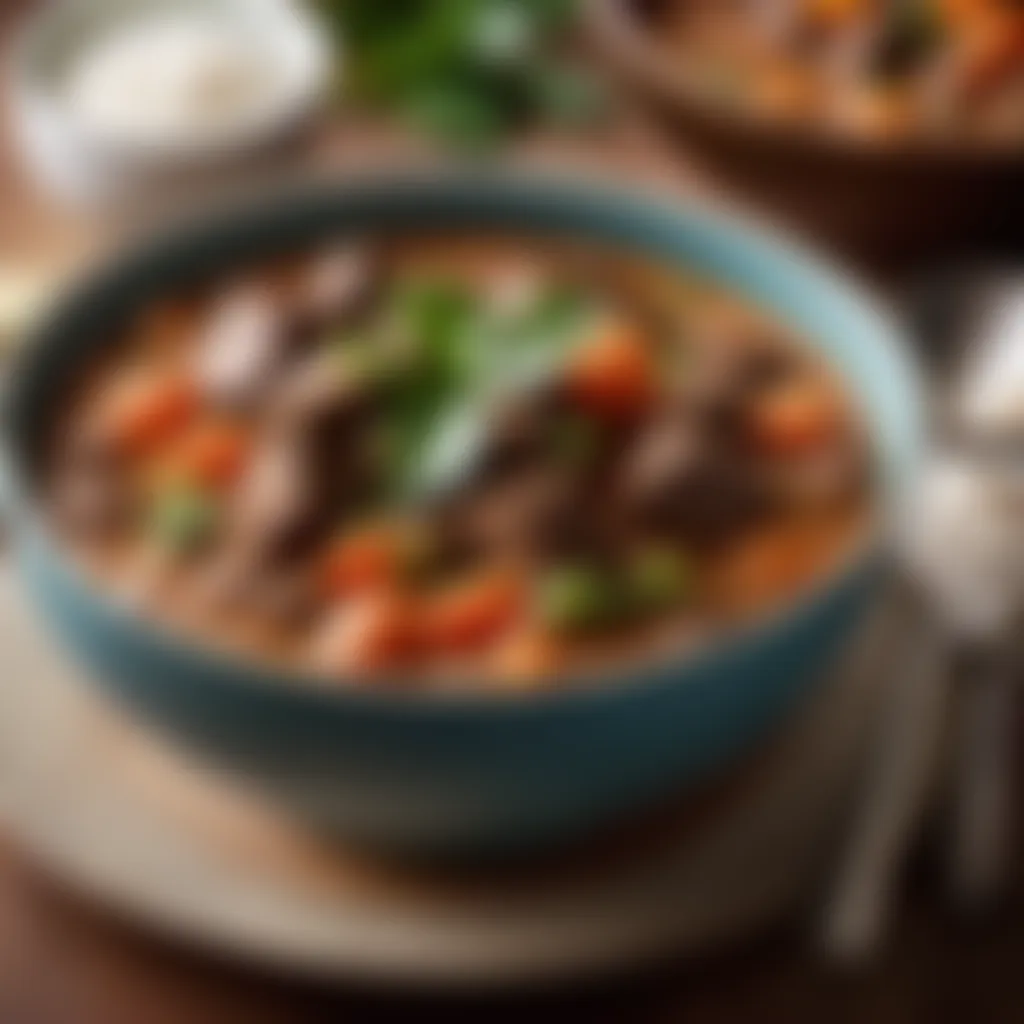Savor the Richness: Delightful Crock Pot Beef Stew


Intro
Crock pot beef stew is more than just a meal; it’s a warm embrace on a chilly day, a satisfying comfort that coats your bones with nostalgia. Whether it’s a dreary Tuesday or a busy weekend, this dish serves not just to fill the stomach but also to create cherished memories around the dinner table. Let’s get down to the good stuff with a dive into the essential elements that will elevate your stew game.
Understanding which ingredients make a difference and the techniques that can enhance your concoction is crucial. You’ll soon discover the joy of letting hearty flavors meld over hours, turning simple components into extraordinary bouquets of tastes. With this guide, you’re about to embark on a flavorful journey—so grab your apron and let’s roll up our sleeves, because it's time to cook!
Ingredients:
When it comes to crafting a mouthwatering beef stew, the quality of your ingredients plays a fundamental role. Here's a comprehensive list of what you'll need:
- 2 pounds of beef chuck cut into 1-inch cubes
- 4 cups of beef broth
- 1 medium onion, diced
- 4 cloves of garlic, minced
- 4 large carrots, chopped
- 3 medium potatoes, diced
- 2 tablespoons of tomato paste
- 1 teaspoon dried thyme
- 1 teaspoon dried rosemary
- 1 bay leaf
- Salt and pepper to taste
- 2 tablespoons of olive oil (for browning the meat)
- Optional: Fresh parsley for garnish
By having all these ingredients in hand, you set the stage for a beautifully rich and flavorful stew.
Detailed Instructions:
Preparation Steps:
- Prepare the beef: Season the beef cubes with salt and pepper. This step can not be skipped as it lays the flavor groundwork.
- Brown the meat: In a skillet, heat the olive oil over medium-high heat. Add the beef cubes in batches, not to overcrowd the pan, and sear them until browned on all sides. The Maillard reaction producing those brown bits will add depth to your stew.
- Sauté the vegetables: In the same skillet, add the onion and garlic, cooking until the onion translucent. Scraping those flavor bits from the bottom of the pan is essential for the final product.
- Assemble your crock pot: In a large crock pot, combine the browned beef, sautéed onions and garlic, carrots, potatoes, tomato paste, thyme, rosemary, and bay leaf. Pour in the beef broth until all ingredients are just submerged.
Technical Aspects:
- Temperature settings: Set your crock pot on low for 6-8 hours or high for 3-4 hours. Cooking on low is ideal for tenderizing the beef effectively.
- Timing specifics: Rule of thumb, always check if the beef is tender; if it’s still tough, it likely needs more time.
- Critical techniques: Stir occasionally if possible, though it’s okay to leave it be. The key here is patience; good things come to those who wait.
Cooking Process:
- Initial cooking: After you’ve set your temperature and timer, allow the stew to simmer away. Resist the temptation to peek too often, as each time you do, you lose precious heat.
- Finishing touches: Near the end of cooking, taste for seasoning. If it needs more depth, consider adding a splash of Worcestershire sauce or a hint of balsamic vinegar to balance the flavors.
- Serving: Ladle the stew into bowls and sprinkle with fresh parsley for that pop of color.
Remember, the longer you let the stew sit, the better the flavors will become, even overnight in the fridge.
Troubleshooting Tips:
- If the stew is too thick: Just add a splash of broth or water to reach your desired consistency.
- If it’s too watery: Mix in a cornstarch slurry (1 tablespoon of cornstarch mixed with 2 tablespoons of cold water) and let it cook for about 15 minutes.
- For a flavor boost: Consider adding a splash of red wine for richer undertones.
With these steps, you’re well on your way to mastering the art of crock pot beef stew. So, roll up your sleeves and get ready to savor the richness of every bite.
The Allure of Crock Pot Cooking
Crock pot cooking has become a cherished method for many home cooks, especially when the hustle and bustle of daily life often calls for quick meals without sacrificing flavor. There's a certain charm to throwing ingredients into a pot and letting the magic happen over several hours. The slow cooking process allows flavors to develop beautifully, creating a rich and hearty stew that warms both the body and soul.
This article explores a variety of crock pot beef stew recipes that not only satisfy the palate but also bring families together around the dinner table. It’s more than just putting food in a pot; it’s an experience that requires understanding ingredients and their chemistry during cooking. Households with busy schedules can greatly benefit from the simplicity and convenience of a crock pot, allowing flexibility to focus on other tasks while dinner simmers away.
Understanding the Slow Cooking Process
A crock pot, or slow cooker, operates by gently heating food at low temperatures over an extended period. This process breaks down tougher cuts of meat and allows spices and seasonings to meld. Unlike traditional cooking methods that may cause food to dry out, the slow cooker retains moisture, resulting in tender, juicy dishes.
As the beef stews away in its flavorful bath, the natural juices combine with the stock, creating a delightful broth that envelopes and enhances each ingredient. For instance, adding a touch of red wine not only bolsters the flavor but also aids in tenderizing the meat further.
LOw and slow are not just terms to describe this cooking technique; they are its foundation. The longer cooking time ensures that every ingredient is infused into the dish, making each bite an explosion of flavor. Understanding this is key to mastering the art of crock pot cooking.
Advantages of Using a Crock Pot
- Convenience: With a crock pot, meal prep is as easy as chopping vegetables and tossing in beef. Set it and forget it, freeing you up for chores, work, or personal time.
- Flavor Development: Slow cooking extracts flavors from meats and vegetables that quick methods may miss. The result is a depth of flavor that is both comforting and satisfying.
- Versatility: A crock pot is not just for stews. It’s capable of cooking a variety of dishes, from soups to roasts, making it a valuable kitchen appliance.
- Energy Efficiency: Compared to the oven or stove, crock pots use less electricity, which can contribute to lower energy bills over time.
- Healthy Cooking: Designed for cooking with minimal fats or oils, crock pots help retain nutrients in vegetables, making for wholesome meals.
The charm of crock pot cooking lies in its simplicity and the love shared over a deeply flavorful meal.
In essence, the allure of crock pot cooking can be attributed to its blend of convenience and the ability to create rich, soul-soothing dishes. For those who value their time in the kitchen but still desire homestyle meals, the crock pot shines as a beacon of culinary potential.
Selecting Quality Ingredients
When it comes to crafting a beef stew that not only warms the soul but also tantalizes the taste buds, the foundation lies in the ingredients. The selection of quality ingredients isn't just a step in the cooking process; it's a crucial element that can turn an everyday dish into a sumptuous delight. Every pinch of herb, every cut of meat, and every vegetable plays its part in building layers of flavor.
Using fresh and high-quality ingredients can make a world of difference. Not only do they enhance the overall taste, but they also contribute to better nutrition. For example, opting for grass-fed beef not only provides a richer flavor but also comes with a healthier fat profile. So let’s dig deeper into what makes up these essential components.
Choosing the Right Cut of Beef
Selecting the right cut of beef is paramount for a successful stew. Tough cuts may take their time to become tender, but once they do, they outperform the pricier options in richness. Some of the top contenders include:
- Chuck Roast: This is the classic choice for beef stew. The marbling in this cut melts during the slow-cooking process, making it juicy and flavorful.
- Brisket: Often celebrated for its unique texture and taste, brisket behaves beautifully when cooked slowly, breaking down into melt-in-your-mouth morsels.
- Round: Leaner than chuck, round cuts can be a good alternative for a healthier meal option but might require a bit more attention during cooking to ensure tenderness.
These choices, with a little patience and love, will lend the stew a depth that can be hard to match.
Essential Vegetables for Stew
Vegetables serve as the backbone of your stew, adding not just flavor but essential nutrients. They soak up the rich broth, making every spoonful burst with wholesome goodness. Here are some must-have vegetables to consider:


- Carrots: Adding a sweet touch, carrots bring a lovely color and texture.
- Potatoes: Versatile and satisfying, they absorb the flavors and provide heartiness.
- Celery: With its crisp structure and mild flavor, celery helps balance the dish.
- Onions: Essential for depth, onions caramelize beautifully during cooking.
Each vegetable has its own role in making the stew balanced and satisfying. Choosing the freshest options at local markets can elevate your dish to something extraordinary.
Herbs and Spices That Elevate Flavor
Don't underestimate the power of herbs and spices in your stew. The right combination can turn a good stew into a great one. Here are some favorites:
- Thyme: This herb carries earthy notes that pair perfectly with beef. Whether fresh or dried, its flavor is consistent and comforting.
- Bay Leaves: A couple of bay leaves tossed in while cooking lend an aromatic quality that’s hard to replicate.
- Parsley: Often used as a garnish, when added in cooking, parsley adds brightness.
- Peppercorns: Freshly cracked pepper enhances the overall flavor, giving just the right amount of kick.
_"Using fresh herbs and spices can significantly transform your stew while offering health benefits. Their impact is as deep as the cooking melange itself."
By carefully picking your herbs and spices, you create a base that heightens every other ingredient. With a focus on quality, your stew will not only be hearty but also a testament to the care you put into your cooking.
Classic Beef Stew Recipes
Classic beef stew recipes hold a special place in the hearts and kitchens of many. These recipes embody the essence of comfort food, transforming simple ingredients into a hearty dish that warms not only the belly but the soul. The beauty of these recipes lies in their simplicity and depth of flavor, achieved through slow cooking that allows every component to meld beautifully. A traditional beef stew brings together tender beef, robust vegetables, and a medley of seasonings, creating an experience that is both nostalgic and satisfying.
Traditional Comfort Beef Stew
This is the type of dish folks often turn to for a cozy family dinner. It starts with chuck roast — a budget-friendly cut that, when cooked slowly, develops a wonderful tenderness. To craft a traditional comfort beef stew, you’ll want to brown the meat first. This step is crucial because it locks in flavors that give the stew depth and character. Using a combination of onions, carrots, and potatoes not only makes for a hearty meal but also balances the rich flavor of the beef. Adding in ingredients like thyme and bay leaves enhances the fragrance, leaving your kitchen smelling divine.
- Ingredients Needed:
- Cooking Process:
- Chuck roast, diced
- Carrots, sliced
- Potatoes, cubed
- Onion, diced
- Beef broth
- Thyme and bay leaves
- Sear the beef in the crock pot before adding other ingredients.
- Layer the vegetables around the beef, and pour in the broth to cover.
- Cook on low for 8 hours or until the beef is fork-tender.
"The magic of a slow-cooked beef stew lies in its ability to evolve from basic components into a savory masterpiece."
Savory Guinness Beef Stew
Taking a step beyond the traditional, Savory Guinness Beef Stew offers a unique twist that incorporates the rich, distinct flavor of stout beer. The addition of Guinness elevates the stew, bringing in a slightly bitter note that balances the sweetness of the carrots and the earthiness of the mushrooms often used in this variation. This recipe showcases the versatility of crock pot cooking, allowing for a robust, flavor-packed meal without the fuss.
- Highlights of This Recipe:
- The beer adds depth and richness.
- Menus well with crusty bread for a complete meal.
- Enhances the flavors of garlic and herbs used in the stew.
Hearty Red Wine Beef Stew
Another delightful twist is the Hearty Red Wine Beef Stew. Here, the choice of wine plays a pivotal role in crafting a stew that feels luxurious. Using a good quality red wine, whether it’s a bold Cabernet or a mellow Merlot, can truly transform the dish. Wine doesn’t just add flavor; it acts as a tenderizer for the meat, resulting in a fork-tender delight. Essentially, it allows for a marriage of tastes that, with a few chopped herbs like parsley or rosemary, can send your culinary skills through the roof.
- Key Ingredients:
- Diced beef
- Red wine, preferably not too sweet
- Onions, garlic, and carrots
- Rosemary and parsley for garnish
You don't need to be a culinary genius to create these sumptuous classic recipes. Each one tells a story, enriching your meal with warmth and tradition, ensuring that your crock pot becomes a prized possession in your kitchen.
Modern Twists on Classic Recipes
The culinary world is ever-evolving, and beef stew is no exception. While traditional recipes hold a cherished place in our hearts, modern twists provide an exciting opportunity to experiment with flavors and ingredients. Infusing contemporary elements into classic beef stew recipes can enhance not only the taste but also introduce health-conscious alternatives that resonate with today's cook. These innovations allow for a broader exploration of global flavors and textures, turning a simple dish into a culinary adventure.
Asian-Inspired Beef Stew
Asian-inspired beef stew brings a complexity of flavors that can make your taste buds tingle. This version often incorporates soy sauce, ginger, and garlic, which lend an aromatic quality to the stew.
For instance, using a cut like shank or brisket gets you tender meat that absorbs those vibrant flavors beautifully. Adding elements like bok choy and shiitake mushrooms further enhances the dish, creating a satisfying balance of texture and richness.
Ingredients you could use for an Asian twist include:
- 2 pounds of beef shank or brisket
- 1/4 cup soy sauce
- 2 teaspoons of minced ginger
- 4 cloves of garlic, minced
- 2 cups of bok choy, chopped
- 1 cup of shiitake mushrooms, sliced
- 2 cups of beef broth
Combine these ingredients in your crock pot, set it low, and let it simmer slow. The result is a hearty stew with an umami flavor profile that stands out from the more typical beef stews.
Mediterranean Beef Stew Variations
Mediterranean cuisine is famed for its robust flavors and healthy ingredients. When considering a Mediterranean twist on beef stew, think of adding olives, tomatoes, and herbs like oregano and rosemary. This gives the stew a bright and refreshing quality, setting it apart from heavier versions.
A suggestion is to use a chuck roast, which becomes fork-tender in the slow cooker:
- 3 pounds of chuck roast
- 1 cup of cherry tomatoes
- 1/2 cup of black olives
- 2 tablespoons of olive oil
- 1 onion, chopped
- Fresh herbs (thyme, rosemary, and a sprinkle of parsley for garnish)
When you prepare this variant, don’t skimp on the olive oil, as it envelops the ingredients in healthy fats while adding depth to the flavor. Spring is a lovely time to enjoy this variation, especially with local tomatoes in season.
Spicy Tex-Mex Beef Stew
If you're in the mood for something with a kick, look no further than spicy Tex-Mex beef stew. By incorporating ingredients like diced green chilies, jalapeños, and a good dose of cumin, you can elevate the humble beef stew into something uniquely hearty and fiery.


A possible recipe includes:
- 2.5 pounds of beef chuck, cubed
- 1 can of black beans, rinsed
- 2 cups of diced tomatoes (canned or fresh)
- 2 jalapeños, diced
- 1 tablespoon of cumin
- 2 cups of beef broth
- Fresh cilantro for topping
Whether you serve it with tortillas or over rice, this stew adds a bit of southern flair that complements the deep beef flavors deliciously. In this instance, the slow cooker helps to meld these vibrant flavors beautifully.
Explore various techniques to blend traditional favorites—each modern twist ensures your beef stew remains exciting and irresistibly flavorful.
The Role of Cooking Techniques
Cooking techniques greatly influence the outcome of any dish, but when it comes to beef stew, they can make or break the final product. In this exploration of crock pot beef stew, understanding these techniques is essential to achieving a rich, flavorful experience. Slow cooking allows flavors to develop over time, but how you apply certain methods can be crucial.
Firstly, the technique itself can enhance texture and taste. For instance, the way beef is prepared before it goes into the crock pot can determine the stew's overall flavor. Additionally, layering ingredients can create a symphony of tastes that interact beautifully over hours of cooking.
Finally, the timing of adding certain components ensures that each ingredient retains its character while blending nicely with the others. Balancing these techniques offers a delightful culinary adventure, that expands the depth of flavors in your stew.
Browning Beef: Importance and Methods
Browning beef is a key step not to be overlooked. It’s not merely about color; browning develops complex flavors through the Maillard reaction. This reaction occurs when proteins and sugars in the meat are heated, resulting in those appealing, rich tastes.
To achieve this, consider the following methods:
- Skillet Browning: Before tossing beef into the crock pot, sear it in a hot skillet with a bit of oil. Aim for a dark golden crust, which can take about 4-5 minutes per side.
- Batch Cooking: Instead of crowding the pan, brown the beef in smaller batches. This will prevent steaming and result in an even better sear.
- Deglazing the Pan: After browning, don’t waste those tasty bits left behind. Pour in some broth or wine to scrape them up, adding even more flavor to your stew.
By investing time in browning your beef, you can elevate a simple stew to a restaurant-worthy dish.
Layering Ingredients for Flavor Development
In cooking, more is often less, but when it comes to layering ingredients in your crock pot, it's a case where careful stacking can amplify taste. Layering means placing ingredients in a thoughtful order to maximize flavor extraction during cooking.
When assembling your stew, try these tips:
- Start with Aromatics: Begin with onions, garlic, and perhaps celery at the bottom. This forms a flavor base that will permeate the rest of the stew.
- Add Meat Next: Follow with your browned beef, ensuring it’s nestled amongst the vegetables for proper flavor meld.
- Top with Veggies: Add heartier vegetables such as carrots and potatoes, which take longer to cook, ensuring they don’t turn to mush.
- Herbs and Spices Last: Save delicate herbs for the end or add them midway to prevent them from losing their aroma and oil.
This careful layering process unlocks the distinct flavors of each component, creating a standout dish.
Timing: A Critical Element in Flavor Extraction
Timing plays an indispensable role in cooking, particularly in a slow-cooking scenario like a crock pot. With each ingredient and step, the moment it hits the warmth affects the outcome. Overcooking can dull flavors while undercooking leaves you with raw additions that disrupt the harmony in your dish.
Consider these timing aspects:
- Beef Cooking Time: Generally, beef should spend at least six hours in a low setting for optimal tenderness. An undercooked piece of meat can carry an unpleasant texture.
- Vegetable Timing: Adding softer vegetables, like peas or zucchini, in the last hour of cooking keeps them vibrant and flavorful.
- Mid-Cooking Seasoning: Don’t wait until the end to taste and season your stew. Monitoring salt content throughout can prevent your mix from becoming overloaded or bland.
In the grand scheme, keeping an eye on timing can lead to a stew that not just satisfies, but delights with every spoonful.
Customization: Personalizing Your Beef Stew
Personalizing your beef stew can take what is already a comforting dish and elevate it to something uniquely yours. Tailoring ingredients and methods not only reflects your individual tastes but also ensures that everyone at the table can enjoy the meal. In a world where dietary needs often vary, customization serves as a bridge, allowing diverse palates to revel in the same hearty bowl of stew.
Adapting Recipes for Dietary Restrictions
One of the most significant aspects of customization is accommodating dietary restrictions. Whether it’s gluten-free, dairy-free, or low-sodium, there’s always a way to enjoy a delicious beef stew.
- Gluten-Free Options: Instead of using traditional flour to thicken your stew, consider alternatives like cornstarch or arrowroot. Both options yield a lovely texture without the gluten drawback.
- Dairy-Free Considerations: If creaminess is a requirement, alternatives such as coconut milk or cashew cream can provide that luscious feel without adding dairy. Just be sure to blend it well before folding it into the stew to avoid clumps.
- Low-Sodium Solutions: Opting for low-sodium broth or even homemade broth can significantly cut down on salt without sacrificing flavor. When seasoning, it’s wise to taste along the way rather than dumping in table salt at the start.
By keeping these substitutions in mind, you can create a beef stew that not only pleases but also accommodates everyone's health needs.
Incorporating Seasonal Ingredients
Utilizing seasonal ingredients can dramatically influence the taste and health benefits of your dish. Not only does this approach provide fresh flavors, it also anchors your beef stew in the essence of the calendar year.
- Spring: Think tender carrots, peas, and baby potatoes. Fresh herbs like oregano can lend your stew an invigorating touch.
- Summer: This season offers a vibrant palette of zucchini, bell peppers, and ripe tomatoes that can bring brightness to your dish.
- Autumn: Root vegetables like sweet potatoes and turnips can add a comforting sweetness that pairs wonderfully with the beef.
- Winter: Sturdy vegetables like parsnips and celery root can provide richness and sustain the heartiness of the dish during colder months.
Incorporating these seasonal gems not only boosts flavor but lends a sense of connection to the earth and its cycles.
Experimenting with Flavors and Textures
Don’t be afraid to let your creativity run wild in the kitchen. Experimenting with flavors and textures can transform a simple beef stew into an extraordinary culinary adventure.
- Adding Depth: Consider including ingredients like mushrooms or smoked paprika for an earthy depth. Both can enhance the umami profile of your stew wonderfully.
- Textural Play: For variety, incorporate grains like barley or toss in some beans. These add a chewy texture that can make each spoonful more dynamic.
- Unexpected Twists: Why not throw in a splash of something unusual like balsamic vinegar or a spoonful of dark chocolate? It may sound odd, but the right amount can add an exquisite complexity and balance the natural sweetness of vegetables.
Customizing your beef stew offers a pathway to find flavors and combinations that resonate with your culinary soul. Whether through adapting to dietary needs, taking advantage of seasonal freshness, or boldly experimenting with diverse ingredients, every alteration can spark joy and create lasting memories around the table.
"In meal times that bring us together, every personal touch speaks volumes of care and connection."


Common Mistakes to Avoid
When it comes to crafting the perfect crock pot beef stew, understanding the common pitfalls can save both time and ingredients. Mistakes during the cooking process can easily turn a robust stew into a lackluster meal. By being aware of these missteps, one can ensure the end product is not only flavorful but also inviting.
Overcooking: Signs and Solutions
Overcooking beef stew is a challenge that even experienced cooks sometimes face. The slow and steady nature of crock pot cooking can deceive. If the stew simmers for too long, the beef may become rubbery and lose its tender texture.
Signs you’ve overcooked your stew include:
- Texture: If the beef feels crumbly rather than tender, it has likely cooked too long.
- Flavor: A muted taste is another indicator. The vibrant, rich flavors might dull when overexposed to heat.
To combat these issues, set clear cooking times based on the recipe. When you enter the final hour, start checking for doneness. If it’s looking good, you can shut off the heat and let it carry over cook instead of prolonging direct heat.
Neglecting Proper Seasoning
Seasoning is often regarded as the backbone of any good stew. Neglecting this can leave your dish as bland as dishwater. It’s vital to realize that seasoning does not just happen at the end. Taste should guide the process. Consider these guidelines for a well-seasoned stew:
- Layering flavors: When introducing herbs and spices, do so in stages. Start with some while browning the beef and add more halfway through.
- Balance: Remember that salt enhances flavor. A sprinkle at various stages can help achieve a balanced profile.
If you discover your stew lacking flavor once it’s finished, it’s not too late. A touch of salt, or a splash of vinegar, can elevate the dish significantly.
Inadequate Preparation of Vegetables
Vegetables play an essential role in the texture and flavor diversity of beef stew. Poorly prepared veggies can lead to unsatisfying results. When vegetables aren’t cut uniformly or aren’t prepped right, it affects cooking time. Here’s how to avoid this mistake:
- Uniformity: Cut your vegetables into similar sizes to ensure even cooking. For root vegetables, medium-sized chunks work wonders.
- Pre-cooking: For ingredients that might cook faster than others, consider sautéing them briefly before adding to the crock pot. This can give them a head start while the sturdier ingredients finish cooking.
"Using the right technique and preparation can elevate your stew from ordinary to extraordinary."
By paying attention to these common mistakes, you’ll be on the right path to creating a truly delightful beef stew. Whether it’s judicious seasoning, perfect timing, or proper preparation, each detail plays a significant role in the final outcome.
Serving and Pairing Suggestions
When it comes to serving beef stew, the experience extends far beyond placing the dish on the table. The enjoyment of a hearty stew is greatly enhanced by the sides you pair with it, as well as the beverages you choose. This section delves into how thoughtful serving suggestions can elevate the overall meal, turning a simple dinner into a warm gathering filled with comfort and satisfaction.
Choosing Appropriate Side Dishes
Choosing the right side dishes for your beef stew is like finding the perfect partner for a dance—you want something that complements without overpowering. The stew itself is rich and flavorful, often full of vegetables and tender meat that are bursting with their essence.
- Bread: A classic pairing is crusty bread. Think sourdough or a nice baguette, which can be slathered with butter and used to soak up every last drop of the savory broth.
- Salad: A light salad can balance the heaviness of a stew. Consider a simple mixed greens salad with a vinaigrette dressing that adds a touch of acidity to cut through the richness.
- Roasted Vegetables: Another well-liked option are roasted vegetables. Carrots and Brussels sprouts pair nicely, adding a textural contrast and further enriching the flavor spectrum on your plate.
- Rice or Noodles: Some folks appreciate a side of rice or even egg noodles to serve under the stew, enhancing the meal's heartiness while absorbing the juices.
These sides not only help to round out the meal, they provide additional textures and flavors that make every bite an exploration of flavor.
Ideal Beverages for Enjoyment
No meal seems complete without a thoughtful beverage to wash it down. The choice of drinks can enhance the flavors of the beef stew significantly.
- Red Wine: A warm glass of red wine, such as a Cabernet Sauvignon or a Malbec, harmonizes incredibly well with beef stew. The tannins in the wine can complement the proteins in the beef.
- Beer: If you’re looking for something lighter, a nice stout or porter can be an excellent choice. They echo the heartiness of the stew without overshadowing it.
- Sparkling Water: For a non-alcoholic option, sparkling water with a dash of lemon can refresh the palate and cleanse it between bites.
- Herbal Tea: Finally, consider an herbal tea, like chamomile or peppermint. They can serve as a soothing end to a hearty meal, refreshing after indulging in rich flavors.
Storage and Reheating Tips
Understanding how to properly store and reheat your crock pot beef stew can make a world of difference in taste and texture. Not only does proper storage preserve the flavors, but it also enhances the overall profile of the dish when it's time to enjoy the leftovers. Whether you’re making a big batch to savor throughout the week or planning for a family gathering, knowing these tips will ensure your stew stays as delicious as the day it was made.
Optimal Storage Conditions
Storing beef stew in the right conditions is essential. Cool your stew to room temperature before transferring it to storage containers. If you place hot stew in the fridge, it can raise the interior temperature, compromising the freshness of other food items. Here are some guidelines:
- Choose airtight containers: Glass containers or BPA-free plastic ones with tight lids work best. Ensure they seal well to prevent any spills or odors from escaping.
- Divide into portions: If you have a large batch, consider dividing it into smaller portions. This not only helps with rapid cooling but also makes reheating a breeze.
- Label your containers: Write down the date on the container. This is an easy way to keep track of freshness, as beef stew is typically best when consumed within 3-5 days when refrigerated.
- Freezing for later: For even longer storage, you can freeze your stew. It's best to allow it to cool completely before placing it in the freezer. Use freezer-safe containers, and it’s advisable to consume within 3 months to maintain flavor and quality.
Reheating Techniques Without Compromising Flavor
Reheating beef stew can sometimes lead to a loss in flavor or texture if done improperly. But, with a few simple methods, you can enjoy your stew just as much as when it was first made. Here are favored techniques:
- Stovetop reheating: This is usually the best method to bring back the stew to its original glory. Pour the desired amount into a saucepan and heat it over medium-low heat. Stir occasionally to prevent sticking and ensure even warming. If it feels too thick, adding a little beef broth or water can help.
- Microwave method: For convenience, microwaving is a quick option, though it requires some care. Use a microwave-safe bowl, cover it loosely with a lid or microwave-safe wrap, and heat in 30-second intervals, stirring in between. This helps to avoid hot spots and uneven heating.
- Oven method: If you have a larger quantity, heating it in the oven can be a good choice. Preheat your oven to 350°F (175°C) and transfer the stew into an oven-safe dish. Cover it with aluminum foil to retain moisture, and heat for about 25-30 minutes, or until warmed through.
Tip: Always taste your stew after reheating. You may find that it needs a little seasoning boost. A sprinkle of fresh herbs or a dash of salt can revitalize the flavors beautifully.
By paying attention to the storage and reheating process, you can ensure your hearty beef stew remains a comfort food delight long after it hits the table.
The End: The Journey of Crafting Beef Stew
Creating a beef stew is more than just a cooking project; it's an experience that melds flavors, techniques, and personal stories into every bite. The journey from selecting quality ingredients to the moment you take that first mouthful is filled with moments of discovery and satisfaction. This article has emphasized that slow cooking with a crock pot not only simplifies the process but also allows the flavors to marry in a harmonious way that can't be achieved in quicker, high-heat methods.
The rich aromas wafting through the kitchen as the stew simmers can evoke memories of family dinners or cold winter nights that make you feel right at home. By taking the time to craft your stew, as explored in the various sections, you embrace the essence of comfort food but also elevate your culinary skills.
Reflecting on the Cooking Experience
The cooking experience often serves as a canvas for creativity. As you stand by your crock pot, patiently waiting for the magic to happen, you might find yourself reflecting on the various touches you’ve added along the way. Maybe it's the way you carefully chopped your vegetables, or how you chose a special cut of beef that you remembered loving from childhood. This reflective practice can be almost meditative.
Each step taken, each adjustment made according to your taste preferences, adds depth to the final product. The engagement in the cooking process fosters a sense of pride; you're not merely following a recipe but crafting a dish that tells your story. There’s a personal touch woven into the fabric of the meal you present to your loved ones, cementing a memory they will cherish.
Encouragement for Culinary Exploration
Don't hesitate to venture beyond the classic recipes we've discussed. Embrace the unique ingredients that reflect the season or your geographical favorites. Perhaps add a splash of bourbon for warmth, or consider incorporating seasonal vegetables like squash when they're fresh and vibrant. Experimenting in the kitchen is where the real learning happens, that’s where you uncover flavour profiles and techniques that might not be in your usual repertoire.
Invite the idea of exploration into your cooking. It’s the small tweaks and flavorful risks that often yield the most rewarding results. Give yourself permission to fail or to be pleasantly surprised by a new combination. The culinary journey is ongoing; each cooking experience adds to your growing knowledge.
In closing, the art of crafting your beef stew transcends mere sustenance. It's a reflection of your creativity, personal history, and connection to those you enjoy it with. Now, more than ever is the time to pick up your apron and embrace the enriching world of crock pot cooking.







